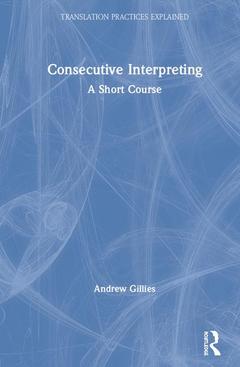Description
Consecutive Interpreting
A Short Course
Translation Practices Explained Series
Author: Gillies Andrew
Language: English
Publication date: 04-2019
· 15.6x23.4 cm · Hardback
Publication date: 04-2019
· 15.6x23.4 cm · Paperback
Description
/li>Contents
/li>Readership
/li>Biography
/li>
Consecutive Interpreting: A Short Course provides a step-by-step guide to consecutive interpreting. This user-friendly coursebook tackles key skills such as presentation, analysis, note-taking and reformulation, as well as advanced market-related skills such as preparation for assignments, protocol and practical tips for working interpreters. Each chapter provides examples of the skill, as well as a variety of exercises to learn the skill both in isolation and then in combination with other skills.
Including model answers, a glossary of terms and further reading suggestions, this is the essential coursebook for all students of consecutive interpreting as well as for interpreter-trainers looking for innovative ways of teaching consecutive interpreting.
Thanks
Part I
1. Introduction
What is consecutive interpreting?
When is consecutive interpreting used?
Who can be a consecutive interpreter?
Why learn consecutive?
Should we learn consecutive before simultaneous?
How good is good enough?
About this book
How to use this book
2. Presentation
Posture
Delivery
Practice
Conclusion
3. Consecutive without notes
A word about memory
Chunking
What you already know
Narrative prompts
Visual prompts
Structural prompts
Logical prompts
Notes
Conclusion
Skills combining
4. Analysis
Structural breakdown
Mind maps
Sections
Mini-summaries
Section diagrams
Logical analysis
Recognizing and splitting ideas
Notes
Skills combining
5. Preparation and practice
Preparation
Exam preparation
Practice
6. Note-taking
Abbreviations
Ideas
Clauses
Verticality
Links
Symbols
Values (more and less important)
What language to note in
Skills combining
7. Noting less
Memory prompts
Things in front of you
Obvious in context
Obvious from the structure of the notes
8. Reformulation
What is reformulation?
Why reformulate?
How to reformulate
How does consecutive facilitate reformulation?
9. Effort management in consecutive
What is effort?
Preemptive effort management
Directionality
Notes as an effort management tool
Part II
10. Advanced presentation
Differences between interpreting and speaking
Style
Preparing for a real meeting room
Looking at your audience
Notes as stage direction
11. Advanced Analysis
Types of speech
Speech analysis in the media
Structure maps
Echos
Rhetorical devices
12. Advanced preparation
Practice
The situation
Preparing the content
13. Protocol and practicalities
Dress code
Interpreting equipment
Survival equipment
What to do when you arrive on site
During the speech and after
Tips from other authors
14. Digitally-assisted consecutive
Simultaneous consecutive
Note-taking on a tablet computer
Real-time transcription
Pros and cons
Appendix 1 Versions of the tasks set
Chapter 2: Presentation
Chapter 3: Memory
Chapter 4: Analysis
Chapter 6: Note-taking
Chapter 11: Advanced analysis
Chapter 12: Advanced preparation
Appendix 2 Memory techniques
The memory palace
Visual linking
Appendix 3 The Example Speeches
1: Javid
2: Jobs
3: Lumumba
4: Ralston
5: Martin Harvey
6: Bishop
7: Sinofsky
8: Homden
9: Gonzales
10: Bett
11: Kyles
12: Obama
13: Asani
14: Barker
15: Haley
16: Romecki
17: Baird
Glossary
Bibliography
Index
Andrew Gillies trains students, interpreters and interpreter-trainers worldwide on behalf of universities, international institutions and the International Association of Conference Interpreters (AIIC). He is the author of several books, including Note-taking for Consecutive Interpreting (2017), and also created the Interpreter Training Resources website.

